From The Ghan to the Indian Pacific and Tasmania’s West Coast Wilderness Railway, these are five of the greatest and most scenic Australian rail journeys.
The best way to visit Uluṟu and Kata Tjuṯa with things to do
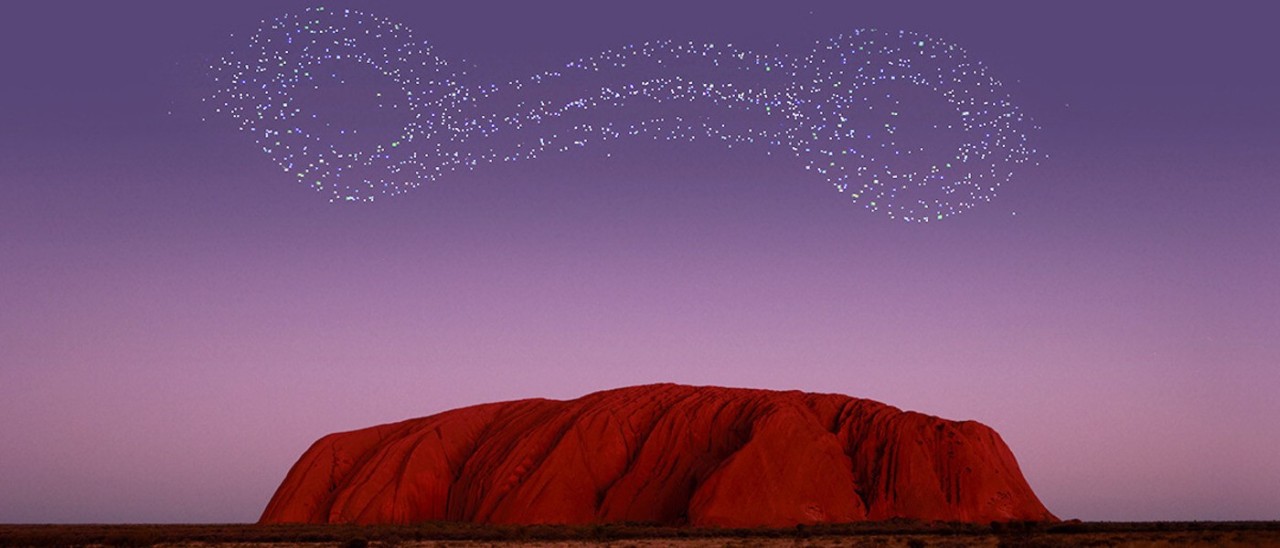
Uluru is more than just a stunning rock formation in the desert: it’s a living cultural landscape, home to ancient traditions, stunning natural beauty and unforgettable outback experiences. Uluru's power lies not just in its geological grandeur, but in the stories, ceremonies and spirit that surround it.
Uluru is part of the Uluru-Kata Tjuta National Park, with Kata Tjuta (the Olgas) also worthy of your attention. While some travellers may only spend a day at Uluru, we recommend allowing at least three days to experience the region’s full glory.
Whether you're visiting for the first time or returning for a deeper experience, this ultimate guide will help you make the most of your journey to one of the most iconic destinations in the world.
RACV Members save more on incredible Uluru travel experiences, including attractions, tours, hotels, car hire and campervan rentals.
More Australian Outback guides
When to visit Uluru
The best time of the year to visit Uluru is between May and September, when daytime temperatures are milder (20-30°C), skies are clear and nights are crisp. This is perfect for sunrise hikes, stargazing and outdoor dining.
Avoid the peak of summer (December to February) if possible, when temperatures can soar above 40°C and some trails may close due to heat.
How to visit Uluru
By air
The fastest way to get to Uluru is by flying into Ayers Rock Airport near Yulara. Direct flights operate from major cities like Sydney, Melbourne and Brisbane, plus some regional towns like Alice Springs, although availability can be seasonal.
By road
Driving to Uluru is an epic Australian road trip experience in itself. From Alice Springs, it’s a 450km drive (about five hours) through stark and stunning desert landscapes. For longer road trips, travellers often journey from Adelaide via Coober Pedy, or from Darwin via the Stuart Highway. Some intrepid travellers even tackle the giant road trip from Melbourne to Darwin through Uluru. If driving, fuel up whenever you can: outback service stations can be few and far between.
By coach
Coach transfers are available from Alice Springs to Uluru and back again. There are also regular hop-on hop-off buses running from Ayers Rock Resort to Uluru and Kata Tjuta, which should be pre-booked to avoid disappointment.
National park entry
All adult visitors entering Uluru-Kata Tjuta National Park must have a valid park pass, which funds park operations, rangers, cultural activites, nature preservation and traditional owner lease payments. The fee is currently $38 for an adult for three days, $50 for an annual pass, and free for under 18s. Northern Territory residents can pay $109 for an annual pass per vehicle, which is valid for the driver and all passengers in the vehicle.
Where to stay at Uluru
The township of Yulara is the main base for Uluru visitors, located just a 20-minute drive from the park entrance. The Yulara Ayers Rock Resort offers accommodation catering to all budgets:
- Sails in the Desert - luxury resort with modern amenities, including the onsite Red Ochre Spa
- Desert Gardens Hotel - offers private balconies with desert views and native gardens
- Emu Walk Apartments - one- and two-bedroom self-contained apartments, ideal for families or friends travelling together
- Outback Hotel - rooms with an ideal mix of comfort and value
- The Lost Camel Hotel - compact rooms without external windows
- Outback Lodge - shared hostel-style accommodation for backpackers
- Ayers Rock Campground - for caravanners and campers, complete with both powered and unpowered sites, plus facilities like a self-service laundry.
All accommodation is managed by Voyages Indigenous Tourism Australia, which reinvests profits into Indigenous training and employment. There's also a selection of daily free activities on offer to guests, including didgeridoo performances, guided garden walks, bush yarns and a bush food experience.
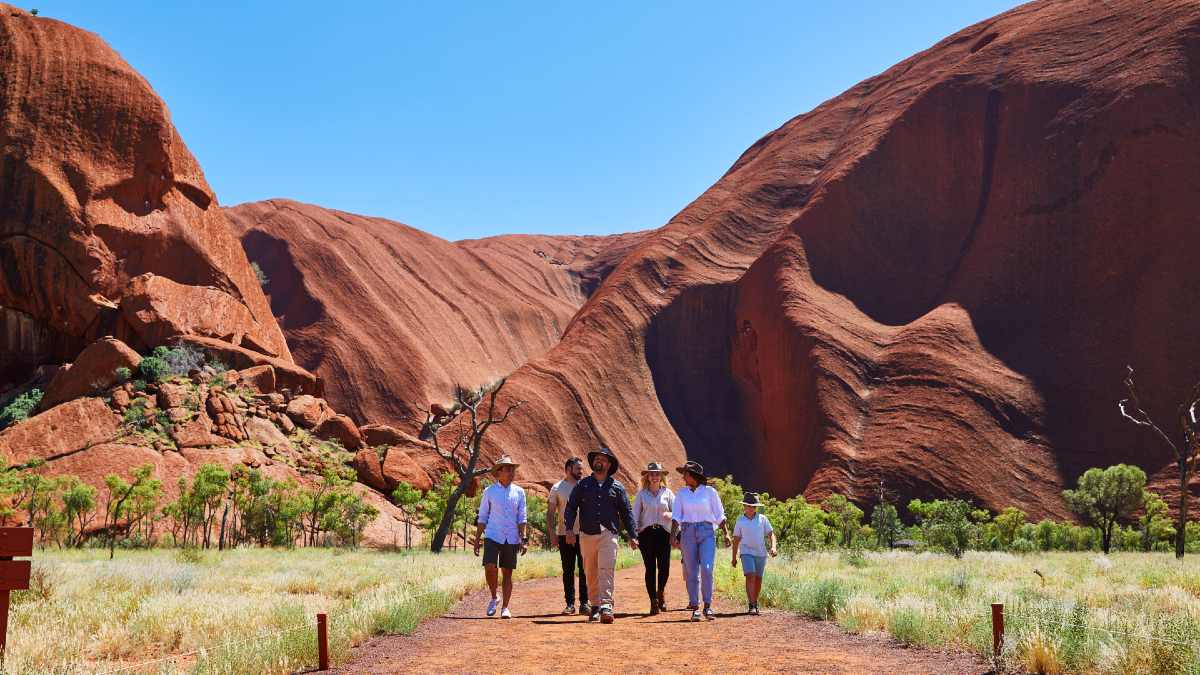
Visiting Uluru is a beautiful and moving experience. Image: Voyages Indigenous Tourism Australia
Things to do around Uluru
Uluru is an estimated 600 million years old and once sat at the bottom of an ancient seabed. It towers over the desert landscape at 348 metres above sea level and has the rare status of holding two UNESCO World Heritage listings (geologically and culturally), thanks to the significance it holds for local First Nations people, the Anangu.
Uluru-Kata Tjuta Cultural Centre
Located within the national park, the Uluru-Kata Tjuta Cultural Centre offers immersive exhibits, art galleries, ranger talks and an introduction to Anangu law, language and stories. It’s a great place to begin your Uluru experience. Follow the Liru Walk path between the centre and the Mala carpark to access other walks.
Uluru Base Walk (10km)
The 10km Uluru Base Walk loop takes about four hours to walk and is the best way to fully experience the Uluru's scale and beauty. The trail winds past waterholes, rock art caves and sacred places, giving insight into the Tjukurpa: the Anangu creation stories. Start early to beat the heat and walk clockwise around the rock. You can join a guided Uluru base walk tour that includes breakfast if you prefer.
Mala Walk (2km)
Traverse the path between the Mala carpark and Kantju Gorge, where you can edge into ancient caves to see rock art that's been on the walls for thousands of years. There's a free daily ranger-led walk to learn about the local Mala story.
Kuniya Walk & Mutitjulu Waterhole (1km)
An easy, shaded walk leads from the Kuniya carpark to a tranquil waterhole nestled in a rock cleft. It’s home to the Tjukurpa (creation story) of a deadly battle between Liru (the poisonous brown snake man) and Kuniya (the woma python woman).
Talinguru Nyakunytjaku Viewing Area
Seeing Uluru from various vantage points across the day is a must to experience its shifting hues and changing atmosphere. Elevated platforms provide stunning photographic opportunities. Talinguru Nyakunytjaku is the best spot for panoramic sunrise views of both Uluru and Kata Tjuta, while the Car Sunset Viewing Area is best for sunsets. If you're staying at the Ayers Rock Resort, the central Imalung Lookout is also a beautiful sunset vantage point of Uluru.
Outback Cycling
Explore Uluru by bike, taking a self-guided morning ride around the base of Uluru over three hours. This leaves plenty of time to explore the Uluru-Kata Tjuta Cultural Centre before returning your bike and helmet. Children are welcome, with smaller bikes available.
Uluru Segway Tours
While you may first feel a little geeky in the safety helmets, a fun segway tour allows you to zip around the Uluru circuit, saving your legs. Regular stops and guide commentary ensure this is an entertaining way to experience Uluru. No experience is needed, with your guide teaching the group how to ride before you take off.
Helicopter flights
For a bird’s eye view over Uluru, consider a scenic helicopter flight for a remarkable perspective over this sacred land. Select from a 36-minute helicopter flight over Uluru and Kata Tjuta at sunset, a 25-minute flight over the two icons in the morning or afternoon, or a 15-minute flight over Uluru only.

Why not see Uluru by segway? Image: Voyages Indigenous Tourism Australia
Wintjiri Wiru drone show
As the vibrant hues of sunset fade behind Uluru, the desert sky becomes the stage for one of the world's most ambitious cultural light shows: Wintjiri Wiru, which means 'beautiful view out to the horizon' in the local Pitjantjatjara tongue. Created in close collaboration with the Anangu Traditional Owners and award-winning studio RAMUS, this immersive experience brings the ancient Mala creation story to life using over a thousand drones choreographed alongside lasers, projections, lighting and narration.
What unfolds above and around you is nothing short of breathtaking. Drones sweep and shimmer to form ancestral symbols ranging from native fauna to ceremony designs, hovering hundreds of metres above the ochre sands. Laser lights ground the performance onto the desert floor, while voiceovers delivered in both English and Pitjantjatjara narrate the Mala story, rooting the experience in deep cultural significance.
The show generally runs twice nightly. Wintjiri Wiru Twilight and Wintjiri Wiru After Dark both offer a similar experience, with unlimited Australian wine on offer plus an Aussie cheese and dessert box to munch on as you marvle at the sound and light show. Elevate your experience with the Wintjiri Wiru Sunset Dinner, which includes a gourmet dinner picnic hamper and premium cocktails made on arrival.
Catch An Ancient Story Takes Flight, a free daily 15-minute documentary on the making of Wintjiri Wiru shown in Ayers Rock Resort's Arkani Theatre.
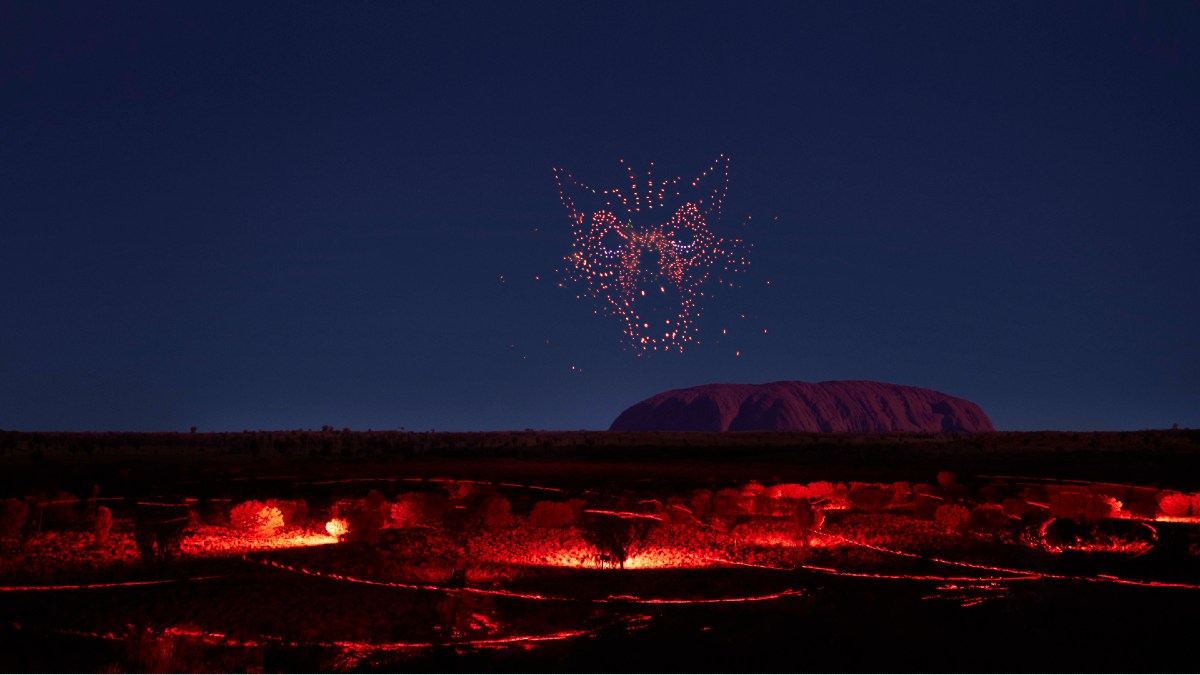
Wintjiri Wiru is an unmissable show at Uluru. Image: Voyages Indigenous Tourism Australia
Field of Lights
As darkness falls over the red heart of Australia, something extraordinary begins to stir at the base of Uluru. Tiny pinpricks of light slowly awaken in the desert, gradually revealing a vast canvas of glowing colour. This is the Field of Light: a mesmerising art installation by British artist Bruce Munro that transforms the desert into a dreamscape of light and wonder. Originally scheduled to be a temporary exhibition, it's been extended indefinitely due to overwhelming popularity.
Installed just outside the Uluru-Kata Tjuta National Park, the Field of Light covers over seven football fields' worth of land with more than 50,000 spindly stems topped with frosted glass spheres. These lights gently bloom and pulse with soft, solar-powered light. In local Pitjantjatjara language, it's called Tili Wiru Tjuta Nyakutjaku: 'looking at lots of beautiful lights'.
Most people visit using the Field of Light General Admission pass, a 1.5-hour after-dark tour. Opt for the Field of Light Star Pass if you'd like to visit at sunset and enjoy outback canapes with sparkling wine or beer before exploring the installation after the sun sets. For a real treat, book into the Field of Light Uluru Dinner. Here you'll enjoy sunset views of Uluru with canapes, chilled sparkling wine and a didgeridoo performance, before tucking into a three-course buffet menu infused with bush tucker flavours while listening to a resident star talker decode the night sky, then exploring the Field of Light after dark.
If you’d rather be tucked up in bed of an evening, visit the Field of Light at sunrise. You’ll arrive in the dark to the magic of the swaying lights. After exploring the installation, you'll get tea, coffee or hot chocolate on a raised viewing platform, with views of Uluru and Kata Tjuta emerging with the sunrise.

The Field of Lights is a popular attraction at Uluru. Image: Voyages Indigenous Tourism Australia
Gallery of Central Australia (GoCA)
Explore local Indigenous artworks at the Gallery of Central Australia (GoCA), a small art gallery with revolving exhibitions onsite at the Ayers Rock Resort. GoCA works with art centres across Central Australia as well as independent artists to source its artworks, most of which are available to purchase. It's open daily from 9am to 5pm.
Explore more local artwork at the Lawn Gallery, located just a few minutes' walk away. Here, Anangu artists paint and sell their art directly to buyers.
Join GoCA's free Paint Your Own Australian Animal workshop at 9.30am from Tuesday to Sunday, where kids with parental supervision can choose a wooden creature and use stencils and paints to make a piece of unique art.
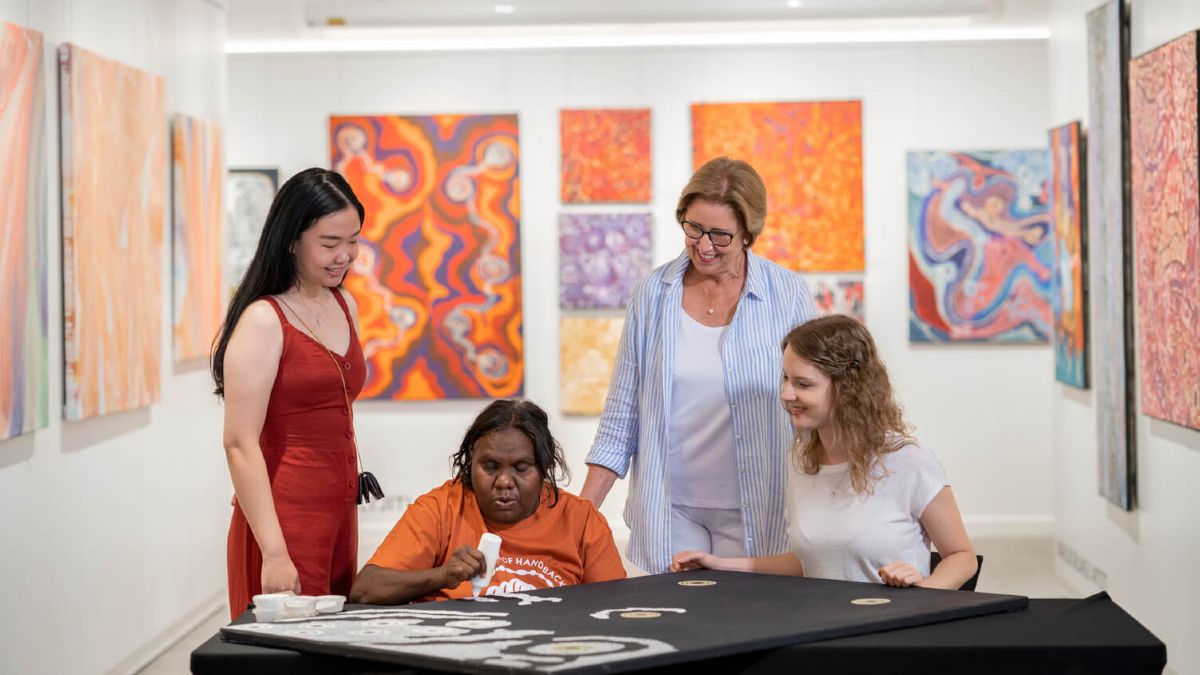
Check out local Indigenous artworks and purchase one to take home. Image: Voyages Indigenous Tourism Australia
Outback Sky Journeys & Uluru Astro Tour
Stargazing is a popular activity at Uluru, with minimal light pollution allowing for stunning starry skies. Explore the southern night sky on the Outback Sky Journeys astronomy tour to learn how to identify common planets, stars and constellations with the naked eye. You'll also get the opportunity to view parts of the galaxy thrugh telescopes. Guides will also share some ancient indigenous stories connected to the stars.
The Uluru Astro Tour uses stronger computerised telescopes on a longer tour with astronomy guides who can personalise the experience to your interests. Whether you're into zodiac signs or planetary movements, learn more about our universe in a dedicated sky viewing area.
Make sure to check out Capturing the Cosmos, a free astronomy documentary playing daily at the Ayers Rock Resort's Arkani Theatre. Narrated by Geoffrey Rush and written by astronomer Dr Tanya Hill, this 45-minute doco introduces radio astronomy, dark energy, and Australia's role at the forefront of research.
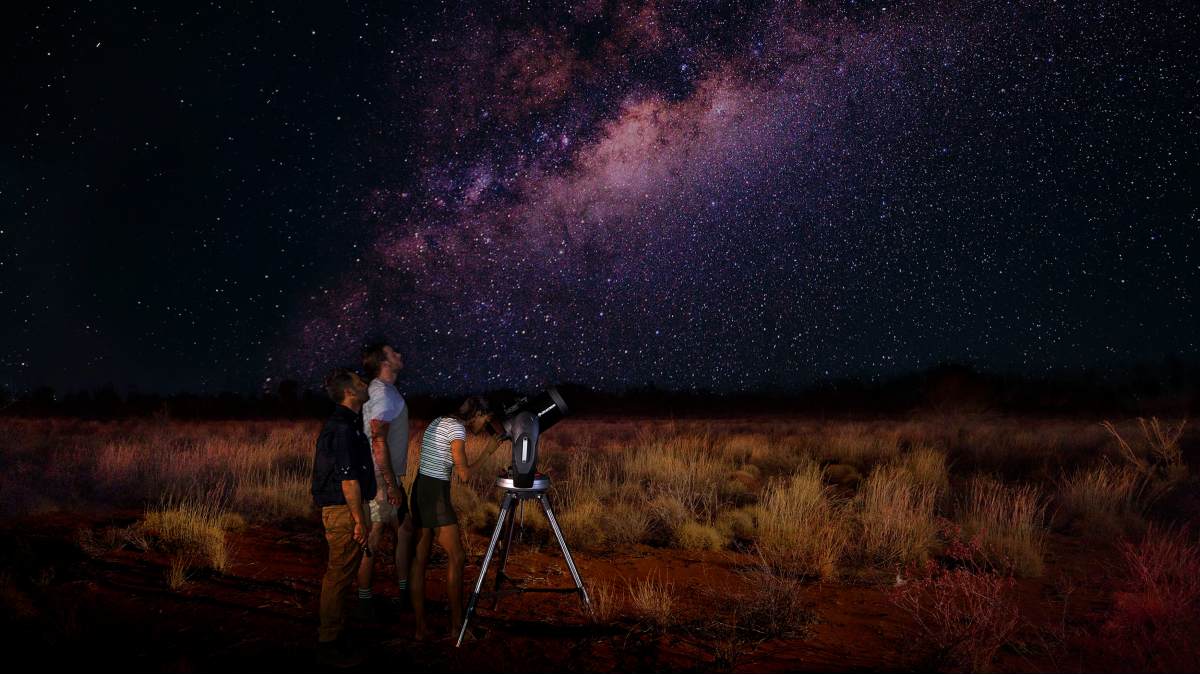
The night skies in Australia's Red Centre are stunning. Image: Voyages Indigenous Tourism Australia
Uluru Camel Tours
Experiencing Uluru from aboard a friendly camel is an unforgettable experience. Uluru Camel Tours operates Australia's largest working camel farm, with over 50 gorgeous camels.
There are three main camel rides to choose from. The Express Camel Ride includes a 45-minute camel ride through the outback landscape, stopping for photos on a sand dune lookout. The Sunrise Camel Experience is a 60-minute camel ride, watching the sun rise over Uluru in the distance and followed by a light breakfast of damper with Aussie jams, tea and coffee. The Sunset Camel Experience is also a 60-minute camel ride, departing just before sunset so you can see the desert colours, and finished off with freshly baked damped plus Aussie beer, wine and champagne.
If you're not interested in a ride yourself, there's still plenty to see at the Camel Farm, which is open daily and free to enter; the free Ayers Rock Resort shuttle bus visits it reguarly. Explore the working saddlery where all the saddles are handmade, plus the small museum covering camels, cameleers (camel handlers), and their history in the outback. Don't miss the gift shop, whichis stocked with camel-themed souvenirs and bush tucker foods.
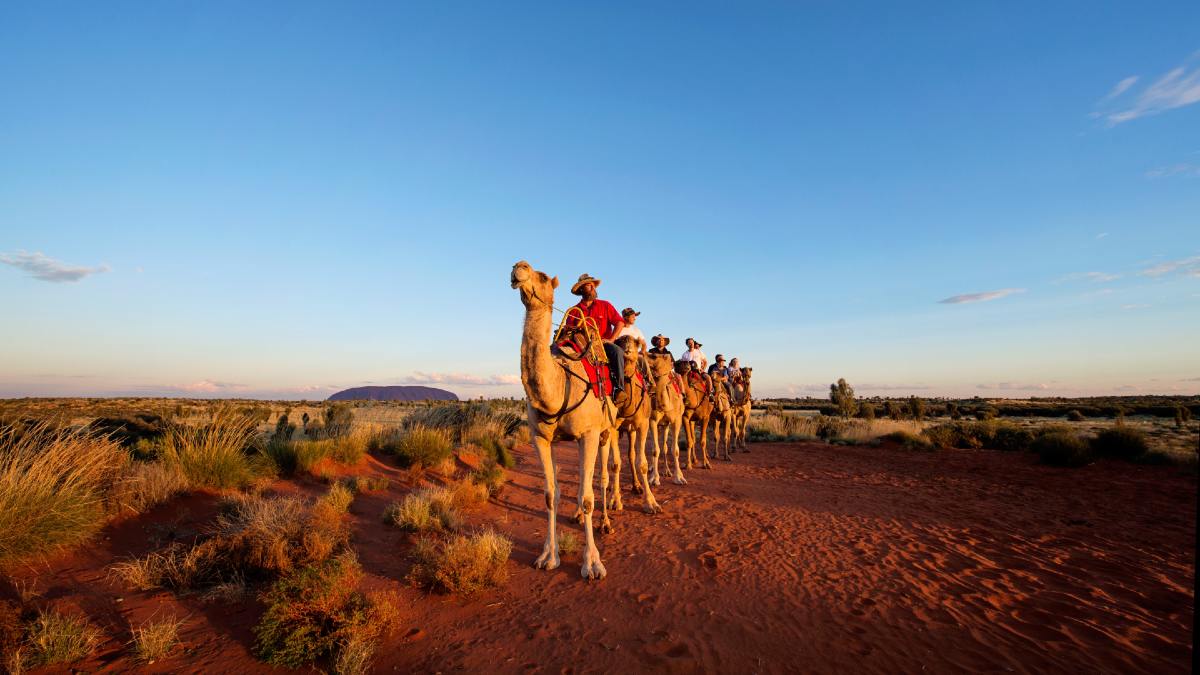
See Uluru in a different way aboard a friendly camel. Image: Voyages Indigenous Tourism Australia
The best way to see Kata Tjuta
No trip to Uluru-Kata Tjuta National Park is complete without experiencing the awe-inspiring beauty of Kata Tjuta (also known as the Olgas). Located around 45 minutes’ drive west of Uluru, these towering domes are often less crowded than their famous neighbour, but just as geologically and spiritually significant. Return bus trips regularly transport visitors from the Ayers Rock Resort to Kata Tjuta.
The best time to visit Kata Tjuta is early in the morning or late in the afternoon, when the light softens and the colours of the rock seem to shift with the sun. Sunrise is particularly magical: watching the domes slowly glow orange and red against a pale desert sky is an unforgettable moment. Head to the Kata Tjuta Dune Viewing Area for panoramic views perfect for photos.
Valley of the Winds Walk
For a more immersive experience, tackle one of the site's iconic walking trails. Those up for more of a challenge should consider the Valley of the Winds Walk, a 7.4km circuit that offers stunning views, unique rock formations and a sense of the area’s vast scale. This track is moderately difficult and best undertaken in the cooler parts of the day, especially during the hotter months.
Waḻpa Gorge Walk
The Waḻpa Gorge Walk is a relatively easy 2.6km return track that winds between two of the largest domes. It takes around an hour and is ideal for visitors with limited time or moderate fitness.
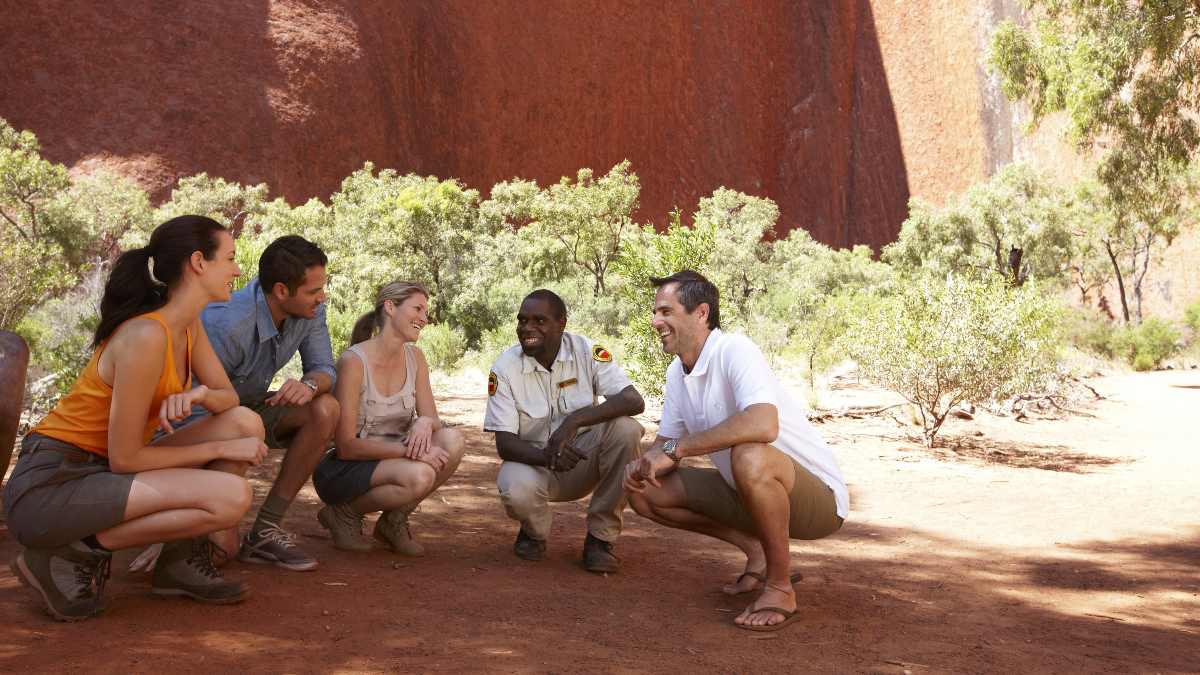
Kata Tjuta boasts some of the area's best walks. Image: Voyages Indigenous Tourism Australia
The best Uluru day trip: Kings Canyon
While Uluru commands much of the spotlight in the Red Centre, a day trip to Kings Canyon offers travellers a striking contrast and an unforgettable adventure. Located within Watarrka National Park, about a three-hour drive from Uluru, Kings Canyon showcases towering sandstone walls, lush palm-filled crevices and panoramic views that rival any in Australia. With an early start and smart planning, you can comfortably explore this natural wonder and be back at your Uluru base by nightfall.
How to get to Kings Canyon from Uluru
If you don't have a hire car, your best bet is the AAT Kings Canyon Day Tour from Uluru. You'll be picked up very early in the morning and driven to Kings Creek Station, a working cattle station that serves up a big cooked breakfast (included in your fare). You're then taken the last leg to Kings Canyon, where you'll split into two groups depending on which walk you choose.
If you do have your own transport, mimic the tour by setting off before dawn at around 4.30am to make the most of the cooler morning temperatures and catch the early light spilling across the desert. The drive itself is scenic and well-sealed via the Lasseter Highway and Luritja Road. Check road conditions and fill up on fuel and water before you depart. There's a café and fuel stop at Kings Canyon Resort nearby the canyon, perfect for a refreshing break before the return journey.
Kings Canyon Rim Walk
The 6km Kings Canyon Rim Walk is the area highlight: a loop that takes three or four hours to trek. The first 500 steps up Heart Attack Hill can be a challenge, but the rewards are immediate: dramatic views across the red rock cliffs; the weathered domes of the Lost City; and the tranquil Garden of Eden, a shaded oasis with a permanent waterhole. If you’re a Priscilla, Queen of the Desert fan, watch for Priscilla’s Crack where an iconic scene was filmed. Shade is minimal on this walk, so bring plenty of water and apply sunscreen.
For those looking for something gentler, the shorter 2.1km Kings Canyon Creek Bed Walk winds along the canyon floor and offers excellent views without the steep climb.
Temperatures can soar by late morning, so aim to start your walk by 8am at the latest. Pack high-energy snacks, a broad-brimmed hat, and at least three litres of water per person.
Kings Canyon helicopter flights
Keen to see Kings Canyon from above? You're in luck: regular helicopter flights fly over Kings Canyon. You'll be transferred from the Kings Canyon Resort nearby, then given a beautiful flight with informative commentary from your pilot. Choose from an astounding 30-minute helicopter flight over Kings Canyon and George Gill Range, a 15-minute flight over Kings Canyon and Carmichael Crag, or an eight-minute 'Canyon Dash' flight.

Kings Canyon is three hours from Uluru. Image: Tourism NT
Dining experiences at Uluru
While options are limited compared to city destinations, Uluru offers several memorable dining experiences like sunset barbecues near Uluru itself.
Tali Wiru
Tali Wiru means 'beautiful dune' in local Anangu language. On this intimate, open-air fine dining experience, you'll enjoy a gastronomic adventure as you sit among the sand dunes with views of Uluru and Kata Tjuta. Upon arrival, you'll be offered champagne and canapes as the sun sets. For dinner, you'll be treated to four courses celebrating native Australian ingredients, expertly paired with Penfolds wines. Before dessert, a local tour guide will share some yarns by the fire.
Sounds of Silence
Sounds of Silence is another open-air dining experience with gorgeous Red Centre views, with outback style canapés, a three-course bush tucker inspired buffet and didgeridoo performances. There's also a selection of Australian wine and beer, along with chilled sparkling wine upon arrival. The menu is served from an interactive chef's station, where you make your choice from the menu. Finish with a talk from the resident astronomy expert, who decodes the southern night sky for the group.
Sunrise Journeys
Sunrise Journeys is an intimate, sensory experience. You'll spend sunrise at a lookout with views of Uluru and Kata Tjuta, enjoying a nourishing outback breakfast with native-inspired flavours plus some Aussie chai tea. As the sun rises, you'll watch an immersive sound and light experience projected on the desert and based on artwork by thee local Anangu women.
Australian Native High Tea
Enjoy a native Australian-inspired menu of sweet and savoury petits fours at the Australian Native High Tea. Complement your treats with an Indigenous organic tea selection and barista coffee, or upgrade to a Bellini cocktail.
Ayers Rock Resort restaurants and cafes
There are several restaurants, bars and cafes to choose from at Ayers Rock Resort, from a casual noodle outlet to premium dining and giant buffets. The Outback BBQ is a fun choice, offering cuts of meat to cook up yourself on the BBQs plus access to a sizeable salad bar.
There is also an IGA supermarket onsite, where you can pick up supplies to feed yourself.
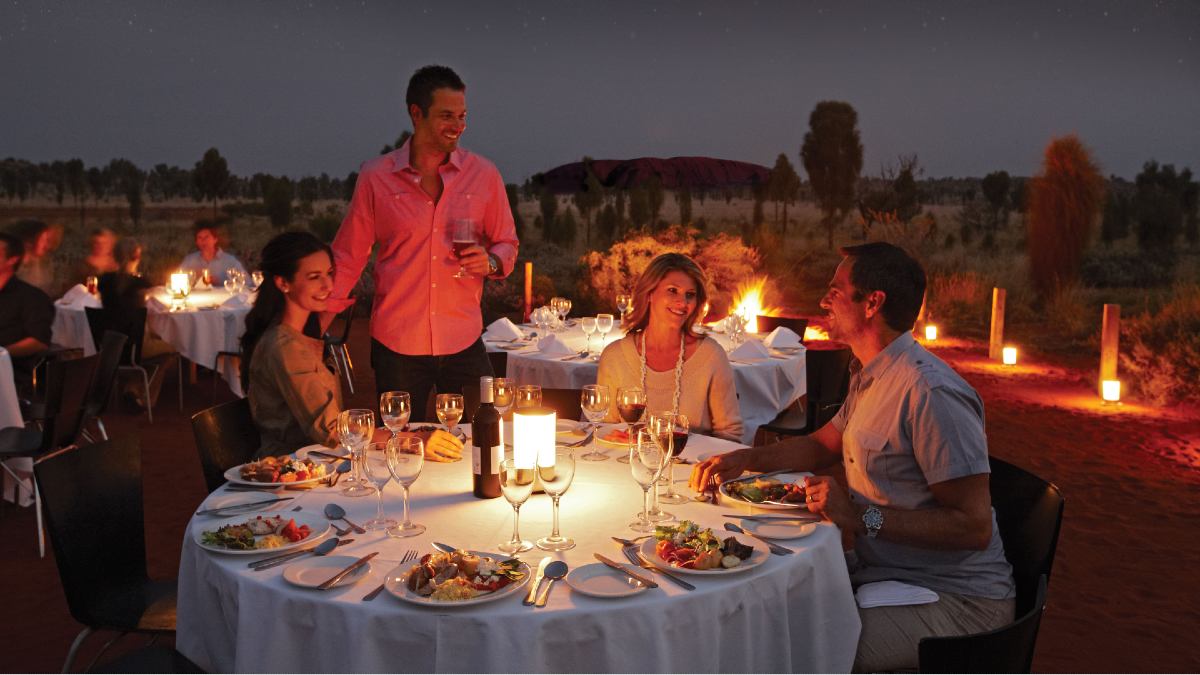
Dine under the outback sky at Sounds of Silence. Image: Voyages Indigenous Tourism Australia
Cultural considerations at Uluru
It's important to be respectful of Anangu culture and traditions while at Uluru-Kata Tjuta National Park. Some things to remember include:
- Don't climb Uluru - in 2019, Uluru's summit was permanently closed to climbers, a decision that honours the wishes of the Anangu people while preventing unnecessary injuries from falls.
- Look for no-photo signs - some parts of Uluru are considered sacred and photography is not permitted. Look for signs along the route, which clearly mark which areas are not to be photographed.
- Leave no trace - stick to designated trails, dispose of rubbish responsibly, and avoid touching rock art or sacred sites.
Safety tips for Uluru
Uluru-Kata Tjuta Park is a remote desert landscape with limited mobile reception and water access. Help keep yourself safe by staying on marked trails, notifying someone if heading out alone, and drinking at least one litre of water per hour while walking outdoors. Check weather forecasts before long hikes, as temperatures can change quickly, and start hikes early to avoid the midday heat.
Help prepare for the area by packing:
- Reusable water bottle - it’s dry out here and important to stay hydrated
- Sturdy walking shoes or boots - ideally with ankle protection over rocky ground
- Sun protection - a broad-brimmed hat, sunglasses and sunscreen
- Fly net - flies can hang around in great numbers, especially in warmer months
- Mobile phone - with plenty of memory for photos and a working SIM card (Telstra has the best coverage in the area)
- Warm jacket - for chilly desert nights
- Headlamp or torch - for evening walks, as the area gets very dark.


